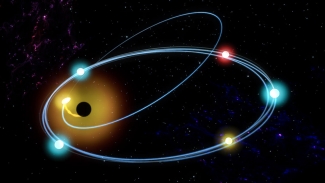The double nucleus of the Andromeda galaxy has been a puzzle since its discovery by balloon-borne experiments in the early 1970s. It is best modeled as a single eccentric disk of stars, which orbits a massive black hole. But how is such an old (Gyr) disk stable? The orbits should differentially precess with respect to one another on Myr timescales! In collaboration with Andrew Halle and Mackenzie Moody, I've discovered that the stability mechanism works like a pendulum - perturbed orbits oscillate about the mean body of the disk due to gravitational torques which changes their eccentriticies and hence their precession rates. Many orbits reached very high eccentricities and the stars are vulnerable to being tidally disrupted by the massive black hole. Check out our original 2018 paper, plus our explorations on the effects of general relativity and mass segregation!



 The Physics Frontiers Centers (PFC) program supports university-based centers and institutes where the collective efforts of a larger group of individuals can enable transformational advances in the most promising research areas. The program is designed to foster major breakthroughs at the intellectual frontiers of physics by providing needed resources such as combinations of talents, skills, disciplines, and/or specialized infrastructure, not usually available to individual investigators or small groups, in an environment in which the collective efforts of the larger group can be shown to be seminal to promoting significant progress in the science and the education of students. PFCs also include creative, substantive activities aimed at enhancing education, broadening participation of traditionally underrepresented groups, and outreach to the scientific community and general public.
The Physics Frontiers Centers (PFC) program supports university-based centers and institutes where the collective efforts of a larger group of individuals can enable transformational advances in the most promising research areas. The program is designed to foster major breakthroughs at the intellectual frontiers of physics by providing needed resources such as combinations of talents, skills, disciplines, and/or specialized infrastructure, not usually available to individual investigators or small groups, in an environment in which the collective efforts of the larger group can be shown to be seminal to promoting significant progress in the science and the education of students. PFCs also include creative, substantive activities aimed at enhancing education, broadening participation of traditionally underrepresented groups, and outreach to the scientific community and general public.